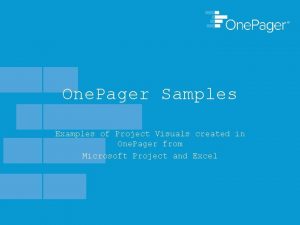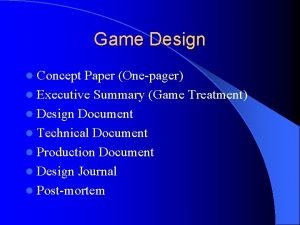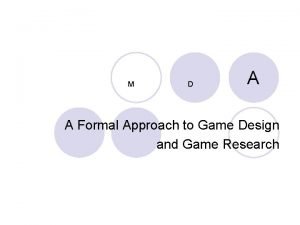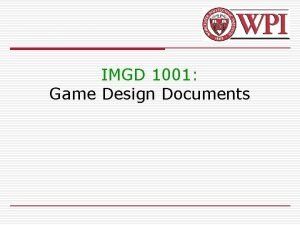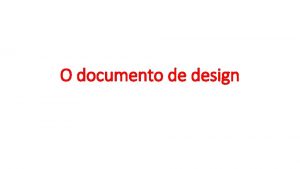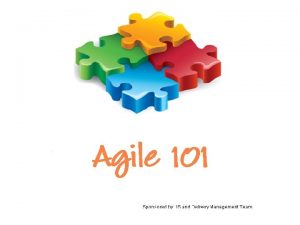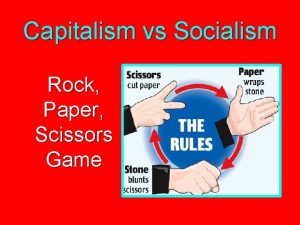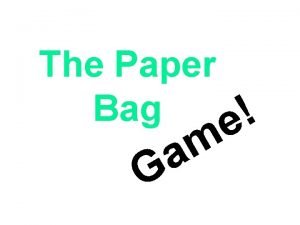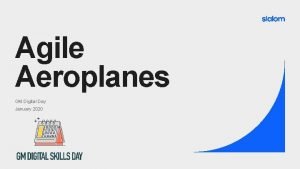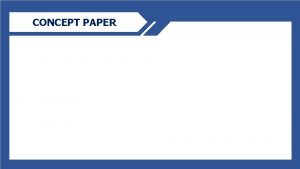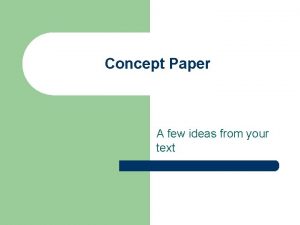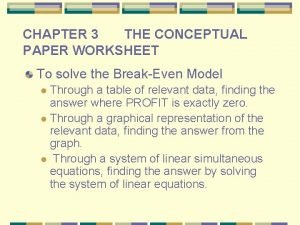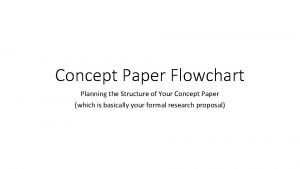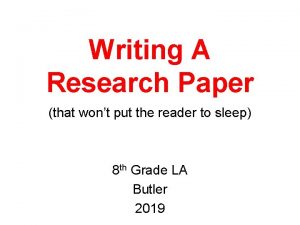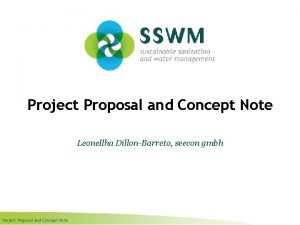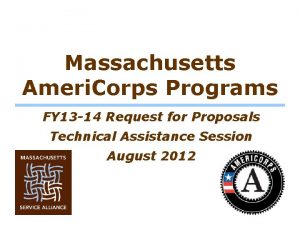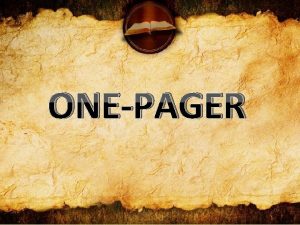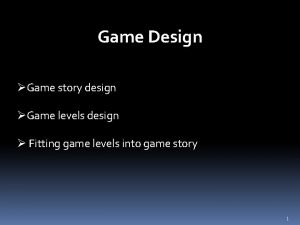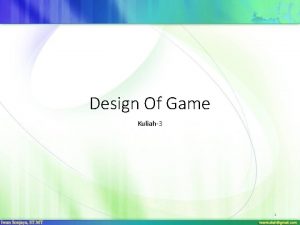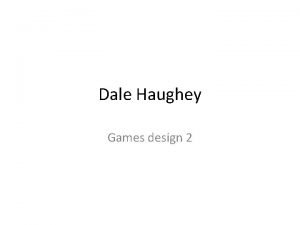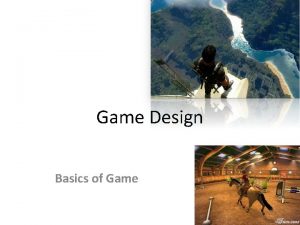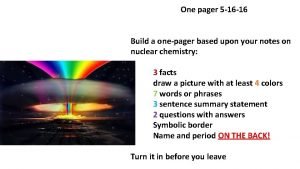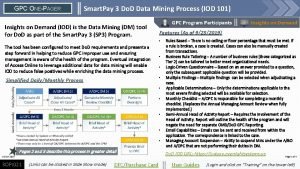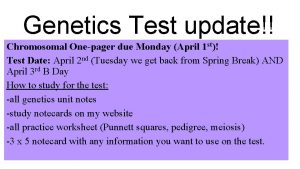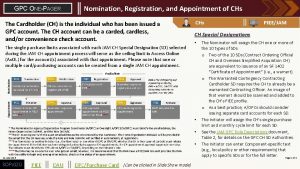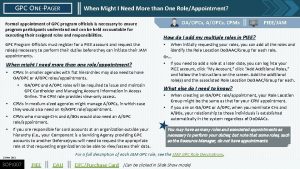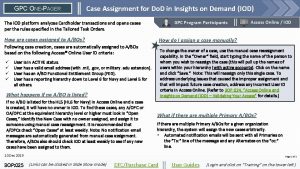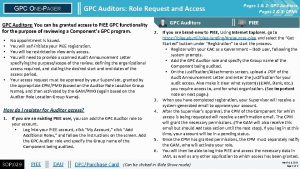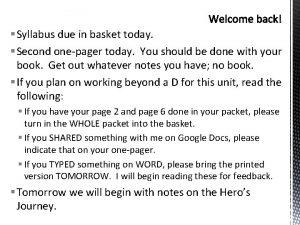Game Design l Concept Paper Onepager l Executive




















- Slides: 20

Game Design l Concept Paper (One-pager) l Executive Summary (Game Treatment) l Design Document l Technical Document l Production Document l Design Journal l Post-mortem

Design Document l Description of entire project – Acts as a script; it should be giving every other professional involved with the product a more than firm idea of what they need to know to implement their portion of the product. Story, characters, features, user-interaction, look & feel, assets, etc. l Living document l Good design not only about ideas, but it's also about the implementation of those ideas. l

One-pager from http: //www. gamasutra. com/features/19991019/ryan_02. htm l Introduction l Background (optional) l Description l Key features l Genre l Platform(s) l Concept art (optional)

Common Mistakes l l l The concept is totally off base or inapplicable to the company's current plans. In terms of resources, the document asks for the moon. The document lacks content. The game isn't fun. The game-concept document employs poor language and grammar.

Design Questions (adapted from Tim Huntsman - Lead Designer for Acclaim‘s WWF Franchise) l l l l l What are current trends? What do people want? What tools/assets/technology do we have access to? What has been done and how was it done? How does the front-end flow? What options or mods should we allow? How is the pacing? How difficult are the levels? Cut scenes vs. run-time movies? Replay value?

Development Ladders Chief Technology Officer Director of Technology Art Director Audio Director Lead Programmer Senior Programmer Junior Programmer Lead Artist Senior Artist Junior Artist Audio Lead Senior Sound Eng. /Comp. Junior S. E. /Comp

Design/Production Ladders CEO Chief Creative Officer VP of Production Creative Director Executive Producer Lead Game Designer Level Designer/ World Builder Associate Producer Assistant Producer QA Testing

Design Considerations l l Cooperation, Conflict, Confusion Formal Abstract Design Tools (Church ’ 99) – INTENTION l – PERCEIVED CONSEQUENCE l – Making a plan in response to the current situation in the game world and one's understanding of the game play options. A clear reaction from the game world to the action of the player. STORY l The narrative thread that binds events together and drives the player forward towards completion of the game.

Design Dos (Adapted from Tzvi Freeman) Describe the body AND soul 2. Make it readable 3. Prioritize 4. Go into details 5. Demonstrate 6. What AND how 7. Provide alternatives 8. Make it “living” 9. Info should be locatable 10. Make it look important 1.

Design Don'ts 1. 2. 3. 4. 5. Never overcomplicate a game if you can help it Never make the same mistake twice Never take control from the player if you can help it Never forget the controller or I/O device you will be using to play the game Never assume the player knows what you're thinking.

Design Don'ts Never break the established rules unless you TELL the player 7. Never assume technology can fix bad design. 8. Never assume the license is all you need 9. Never cheat the player 10. Never design morality. 6.

Design Document #1: Overview - recap and revision of the original concept paper l The User Experience – Genre, Type – Compelling aspects The Platform l The Users l Time l – Game-play time – Product life

Design Document #1: Overview l Basic Concepts l Navigation Chart l Scenes and Action l List of Resources

Design Document #1: Basic Concepts - feel for the game, why things are the way they are, and what the essential, indispensable elements are l Storyline – The background story – Storyline or object of the game play – Rules of the game l Heroes and Villains – biographical information and descriptions. l Novelties and Compelling Features

Design Document #1: Navigation Chart - An illustration of how parts of the game link to each other. l Entry and exit Main menu l Level movement l Access to preferences and credits l Global Behaviors – Ensures that your game will have a consistent feel to it. – buttons, life-bars, input devices, etc. – animations, at least in stick form.

Design Document #1: Scenes and Action - In an adventure game, this will take up most of your document. l preferences, credits, and main menu. l In subchapters, lay out consistent behaviors of local elements. l Optional Storyboard

Design Document #1: List of Resources - should be thorough. Leaving out even a few items, or failing to describe them clearly, could prove a major source of exasperation later on. l This section comprises detailed lists of models, animations, sounds, music, narration, backgrounds, etc.

Design Document #2 l l l Revised game concept doc Market analysis Technical analysis Legal analysis Cost and revenue projections Art

Design Document #3: FEATURE-ORIENTED Goals are broken down into doable bits. 1 FEATURE HEADING 1. 1 Contact 1. 2 Goals 1. 3 Implementation 1. 4 Impact 1. 5 to 1. 8 Tasks & Questions for: l – Designers, Programmers, Artists, Sound

Design Document Resources l http: //www. ihfsoft. com/designdocuments. ht m l http: //www. designersnotebook. co m/Lectures/BGDNT. zip l http: //www. gamasutra. com/
 One-pager script examples
One-pager script examples Project one pager examples
Project one pager examples One pager game design
One pager game design A formal approach to game design and game research
A formal approach to game design and game research Game design documents
Game design documents High concept game
High concept game Aice english paper 2
Aice english paper 2 Aice general paper practice test
Aice general paper practice test Traditional teams
Traditional teams Rock paper scissors adam smith
Rock paper scissors adam smith Christian aid paper bag game
Christian aid paper bag game Paper plane game agile
Paper plane game agile Concept paper for dissertation
Concept paper for dissertation Concept paper meaning
Concept paper meaning How to make a concept paper
How to make a concept paper Concept paper worksheet
Concept paper worksheet Concept paper structure
Concept paper structure Research paper format
Research paper format Concept proposal
Concept proposal Example of timeline in concept paper
Example of timeline in concept paper Concept paper
Concept paper

